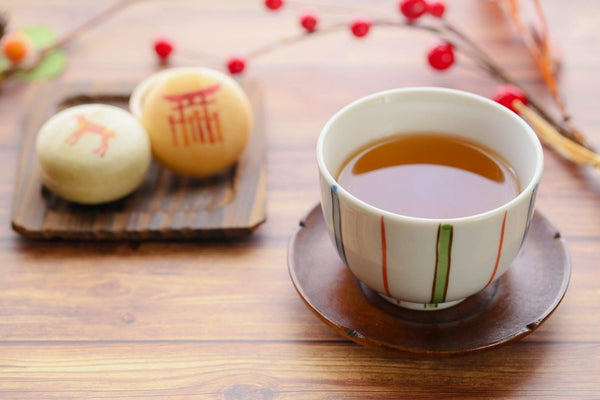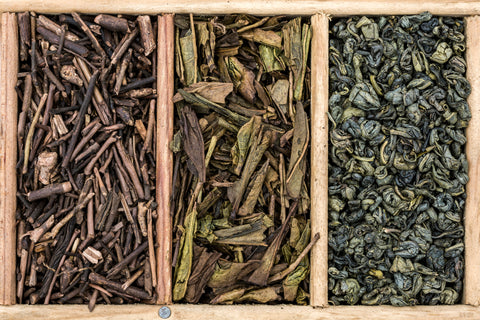
Jump to:
The terms “Japanese tea” and “green tea” are often used interchangeably, but did you know that one of the main varieties of Japanese tea is not even green in the form most of us encounter it?
Although classed as green tea, the leaves used in Hojicha are roasted until they are given a reddish-brown hue. The unique characteristics this process gives Hojicha have made it a popular choice for Japanese tea drinkers, both in Japan and abroad.
Before we look at its origins, health benefits, and other aspects of Hojicha let us first consider what Hojicha actually is.
What Is Hojicha?

Like all true teas, Hojicha is made from the Camellia sinensis plant. However, the way that this one plant is grown and how it is processed greatly affect not only the appearance of the tea but also its aroma and taste profile.
Once the tea is picked and the leaves are exposed to oxygen, a chemical reaction starts and enzymes start to turn the polyphenols known as catechins into other polyphenols called flavonoids. If this oxidization process is allowed to continue unabated, you get the black tea you find gracing English teapots. Whereas black tea is fully oxidized, green tea is unoxidized. So, how does the green tea farmer stop the tea from oxidizing?
This is done by steaming the leaves of the tea after harvesting. This prevents the catechins from being converted to theaflavins and means that it retains its vegetable-like, or grassy tones. As we have mentioned, however, Hojicha has a very different taste profile to this, so what makes Hojicha different from other green tea?
How Is Hojicha Different From Other Green Tea?

Hojicha, like other green tea, is also steamed, but then goes through a further step that lowers the level of these catechins, removing its astringency and providing its signature earthy aroma and taste.
After being steamed and dried, the tea is roasted using either a large roasting machine (reminiscent of a cement mixer), a large hot pan, or, in rare cases, by hand. For larger batches, the leaves need to be separated by size to ensure that all the Hojicha in each batch is roasted evenly.
In addition to changing the color of the tea leaves, this gives it warmer flavors more reminiscent of coffee or chocolate. This makes this unique Japanese tea (which is both brown and green at the same time) an ideal entry tea for coffee drinkers.
Origins Of Hojicha

Japanese tea drinking is said to date back to the 8th Century, but Hojicha’s history is much shorter. In fact, people have only been drinking Hojicha for just over a century.
What is more, this popular form of drinking Japanese tea appears to have come about by accident!
Like many other green tea stories, the story of Hojicha begins in Kyoto. It is said that in 1920, a tea merchant had a leftover batch of Bancha he couldn’t shift, so he decided to see what would happen if he roasted the leaves, along with the stems of the plant. He liked the results and the rest, as they say, is history.
What Is In Hojicha?
With Hojicha, it is definitely a case of “waste not, want not”. Just like that first tea merchant over a century ago in Kyoto, tea farmers today want to utilize as much of their crop as possible.
Whereas so-called high-grade teas, such as “Gyokuro” and “Shincha” use only select leaves harvested at certain times, the roasting process means that the older leaves of the tea plant can be used, and even the stems may be thrown in for good measure.
If you'd like to learn more about other kinds of Japanese green tea, you can learn all about them in this article.
How To Brew Hojicha?

You might expect that once the leaves are prepared, the brewing process for all Japanese tea would be the same. But there is, in fact, a key difference when brewing Hojicha.
With regular green tea, the temperature of the water used when brewing needs to be carefully controlled to avoid removing catechins from the tea. These catechins are already removed in the roasting process for Hojicha, however, so hotter water (around 80 degrees Celsius) can be used. This not only brings out the “warmer” taste profile of Hojicha but also makes it a good option for those of us who like our tea piping hot in the winter.
When brewing Hojicha, simply put 5 grams of tea leaves into a teapot, pour in 150ml of hot water (80 degrees Celsius), leave for approximately one minute, and pour out through a strainer.
As with all Japanese tea, a handy tip is to pour away any unused tea from the pot after you finish serving yourself and/or your guests. This stops the tea from “stewing” and means you can typically reuse the leaves in the pot up to around five times. This makes this already very economical drink go even further.
Health Benefits

When looking at the health benefits of green tea as a whole and Hojicha, in particular, it can be viewed as somewhat of a trade-off between nutrition and caffeine.
The roasting process has been shown to reduce the levels of catechins and antioxidants in green tea, which are linked to many of its health benefits.
These include (possible) weight loss, bolstered immune system, skin improvements, and reduced risk of cancer and strokes. Indeed, a study conducted on Hojicha specifically, could not find any positive or negative benefit related to strokes.
Additionally, as Hojicha normally uses older leaves that have not been raised in intensely shaded environments, you do not get the intense l-theanine amino acid boost present in the sweeter teas, such as “Gyokuro”.
These elements are still present to some degree, however, making Hojicha a beverage with a well-rounded nutritional profile. Additionally, the fact that they use older leaves means that it has a higher mineral content and is good for digestion.
One thing that makes it a good choice for many people is that Hojicha allows you to enjoy these nutritional goodies without needing to consume large amounts of caffeine, making it a healthy and accessible choice for those who are sensitive to the effects of caffeine.
Hojicha and Caffeine

Hojicha retains many of the health benefits of other green tea, with the added benefit that its low caffeine content means that it can be drunk in the evening and by the caffeine-sensitive among us.
There are two main reasons why Hojicha has less caffeine than some other green teas. The first is that the older leaves and stems used for making Hojicha naturally have lower levels of caffeine to start with. Added to that, much of the caffeine is removed in the roasting process.
So why would the older leaves have less caffeine than the younger ones? To answer that we need to look at the role caffeine plays in tea plants. The plant produces caffeine to make itself distasteful to insects. As insects gravitate to the yummier younger leaves, these young leaves naturally have more caffeine. It follows, therefore, that the tougher older leaves do not need to produce as much.
Caffeine-content Of Hojicha
So how much caffeine does Hojicha have? While not caffeine-free like “Mugicha” barley tea (which, by definition, is not really “tea” at all), Hojicha is definitely low in caffeine. Although many factors affect the caffeine content, including the age of the leaves used and the ratio of stems used, a good rule of thumb is that it has approximately a tenth of the amount of caffeine contained in coffee, and gyokuro, and around half of that found in sencha.
Different Types Of Hojicha

The two main types of Hojicha are leaf Hojicha and stem Hojicha, which, as the name suggests are made by roasting either the leaves or the stems of the tea plant.
Among the broad category of leaf Hojicha, the type of leaves used will also affect the aroma and the taste. The two main types of tea leaves used are sencha or bancha leaves, which are the younger or older leaves, respectively.
Kuki Hojicha uses stems instead of leaves. A famous variety of Kuki Hojicha is “Kaga Boucha”. This comes from the Kaga region of Ishikawa Prefecture and has different subtleties of flavor and aroma to leaf Hojicha.
Aside from the ingredients used, the difference in roasting times, whether it is a light or dark roast, will also affect its profile. Try out a few and see which one you like best!
Other Ways To Enjoy Hojicha?

Although Hojicha is most commonly enjoyed as a hot drink made with loose leaves, there are many other ways to enjoy it. Taking its cue from Matcha, you can get Hojicha powder made from ground Hojicha leaves. Although painfully bitter in its neat form, this can be combined with milk and sugar to make a delicious Hojicha Latte. It can also be mixed into cookies or cakes, or used as flavoring for ice cream.
On a hot summer’s day, cold brew Hojicha is also a refreshing, healthy, and non-caffeinated way to stay hydrated for people who find it a struggle to gulp down huge quantities of water.
Alternative ways of enjoying Hojicha don’t stop at food and drink either, as the signature earthy, relaxing aroma of Hojicha can even be found in bath salts.
Foods Hojicha Pairs Well With

The roasting of Hojicha brings out the warmer notes of the tea, such as cinnamon, chocolate, and coffee, so it is no surprise that Hojicha pairs well with simple snacks with warmer taste profiles, such as nuts and dried fruit.
Hojicha is commonly served in Japanese restaurants as a “free” drink provided with your meal, and many find that it has the effect of clearing your palate, providing a balancing effect when you are eating greasy or otherwise heavy dishes.
Hojicha is a great accompaniment to a meal when it comes to dessert as well. The full-bodied roasted, earthy flavors mean that it pairs extremely well with both chocolate-and citrus-based desserts.
Where To Buy Hojicha
Hojicha can be purchased in a variety of forms, including loose-leaf, powdered form, and tea bags if you prefer.
You can buy Hojicha in supermarkets in Japan, but if you are interested in trying a wide variety of types, as well as organically-grown Hojicha, your best bet may be online stores or specialist tea stores. To purchase authentic hojicha straight from Japan, be sure to check out the selection at Japanese Taste.
Other Benefits

When looking for a great Japanese tea to enjoy, Hojicha is a great choice due to its warm, earthy tones and its soothing, smoky aroma. As previously described, it is both low in caffeine and includes minerals that aid digestion, which makes it a particularly good candidate for tea to enjoy after your evening meal.
Another reason is that it is kind to your wallet. As Hojicha uses the less-expensive larger leaves and stems, it retails at a much cheaper price than premium-grade teas such as gyokuro.
Have you tried Hojicha yet? How do you like it compared to other types of green tea? Let us know in the comments!


0 comments